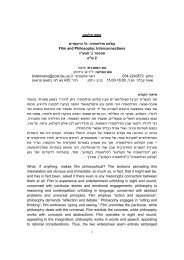The Iconography of the Temple in Northern Renaissance Art
The Iconography of the Temple in Northern Renaissance Art
The Iconography of the Temple in Northern Renaissance Art
Create successful ePaper yourself
Turn your PDF publications into a flip-book with our unique Google optimized e-Paper software.
study focuses on Flemish fifteenth century representations <strong>of</strong> <strong>the</strong> <strong>Temple</strong>, which<br />
are based on <strong>the</strong> Dome <strong>of</strong> <strong>the</strong> Rock pattern.<br />
Kr<strong>in</strong>sky's article (1971) is an important review which surveys <strong>the</strong> <strong>Temple</strong>'s<br />
images and its transformations through <strong>the</strong> ages, from <strong>the</strong> early Middle Ages<br />
to <strong>the</strong> <strong>Renaissance</strong> <strong>in</strong> both Eastern and Western art. Although <strong>in</strong> some cases<br />
Kr<strong>in</strong>sky alludes to <strong>the</strong> mean<strong>in</strong>g <strong>of</strong> <strong>the</strong> <strong>Temple</strong>'s representations, his study is<br />
mostly devoted to its visual aspects. 5<br />
Haussher (1968) focuses on <strong>the</strong> Solomonic <strong>Temple</strong>'s representations <strong>in</strong> some<br />
thirteenth century French Bibles Moralisées, <strong>in</strong> which <strong>the</strong> Byzant<strong>in</strong>e ciborium is<br />
adopted for <strong>the</strong> Jewish <strong>Temple</strong> and contrasted with a Gothic construction which<br />
stands for <strong>the</strong> Church. Although Haussher contrasts <strong>the</strong> Templum Solomonis<br />
with <strong>the</strong> Ecclesia Christi, his study cl<strong>in</strong>gs to <strong>the</strong> descriptive aspect and neglects<br />
<strong>the</strong> ideological background.<br />
Walter Cahan's study (1976) throws new light on <strong>the</strong> assimilation <strong>of</strong> <strong>the</strong><br />
Solomonic <strong>Temple</strong> and <strong>the</strong> Church. He shows how sacred Solomonic elements,<br />
ma<strong>in</strong>ly <strong>the</strong> "Jach<strong>in</strong>" and "Boaz" columns, are <strong>in</strong>corporated <strong>in</strong>to Romanesque<br />
Church architecture and merge <strong>the</strong> idea <strong>of</strong> <strong>the</strong> <strong>Temple</strong> with <strong>the</strong> Church; an<br />
idea to be developed later by Jean Fouquet.<br />
Pan<strong>of</strong>sky, 6 <strong>in</strong> his study <strong>of</strong> iconographical issues <strong>in</strong> early Ne<strong>the</strong>rlandish<br />
pa<strong>in</strong>t<strong>in</strong>g suggests, albeit briefly, that <strong>the</strong> <strong>Temple</strong> <strong>of</strong> Jerusalem may symbolise<br />
Synagoga and/or Ecclesia, and also Synagoga as opposed to Ecclesia, depend<strong>in</strong>g<br />
on <strong>the</strong> architectonic type. It is this suggestion that provided <strong>the</strong> start<strong>in</strong>g po<strong>in</strong>t<br />
for <strong>the</strong> follow<strong>in</strong>g essay, <strong>in</strong> which <strong>the</strong> mean<strong>in</strong>gs <strong>of</strong> <strong>the</strong>se different patterns will<br />
be exam<strong>in</strong>ed. <strong>The</strong> preference for one <strong>of</strong> <strong>the</strong>se forms or for <strong>the</strong> confrontation <strong>of</strong><br />
<strong>the</strong> <strong>Temple</strong> as a Gothic church with <strong>the</strong> <strong>Temple</strong> as an Oriental-type structure,<br />
or as <strong>the</strong> Dome <strong>of</strong> <strong>the</strong> Rock, may be considered on a symbolic level. It will<br />
appear, I believe, that <strong>the</strong>se different forms are analogous <strong>in</strong> mean<strong>in</strong>g to <strong>the</strong><br />
notion <strong>of</strong> <strong>the</strong> opposition between <strong>the</strong> Old Law and <strong>the</strong> New; i.e., Synagoga<br />
versus Ecclesia.<br />
We f<strong>in</strong>d two pr<strong>in</strong>cipal attitudes towards <strong>the</strong> <strong>Temple</strong> <strong>in</strong> <strong>the</strong> <strong>the</strong>ological<br />
sources. In some biblical commentaries, <strong>the</strong> <strong>Temple</strong> symbolises <strong>the</strong> Old Era,<br />
especially <strong>the</strong> ru<strong>in</strong>ed <strong>Temple</strong> which has been replaced by <strong>the</strong> Church - <strong>the</strong><br />
New <strong>Temple</strong>. In a different approach, deriv<strong>in</strong>g especially from <strong>the</strong> Paul<strong>in</strong>e<br />
literature and commentaries, Christ himself, as well as <strong>the</strong> Christian community<br />
<strong>of</strong> <strong>the</strong> faithful, is seen as <strong>the</strong> New or True <strong>Temple</strong>, which is <strong>in</strong>terpreted as <strong>the</strong><br />
Church (Ecclesia). 7<br />
<strong>The</strong> idea <strong>of</strong> rebuild<strong>in</strong>g <strong>the</strong> Church out <strong>of</strong> <strong>the</strong> ru<strong>in</strong>ed <strong>Temple</strong> is expressed <strong>in</strong><br />
Jean Pucelle's Calendar <strong>in</strong> <strong>the</strong> first volume <strong>of</strong> <strong>the</strong> Belleville Breviary (Paris, B.N.<br />
lat. 10483, vol. 1). In <strong>the</strong> bas-de-page <strong>of</strong> each <strong>of</strong> <strong>the</strong> Calendar folios, <strong>the</strong><br />
148
















